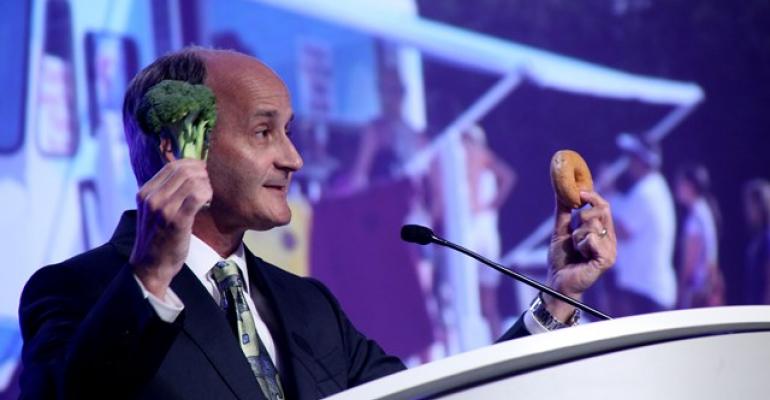TRAVERSE CITY, MI – Much has been written about the waning fortunes of green cars, which include battery-electric vehicles, hybrids, plug-in hybrids and fuel-cell vehicles.
With gas prices down, so are the sales and resale values of many models with alternative powertrains.
Through July, WardsAuto data shows hybrids fell 18.5% vs. year-ago, while PHEV deliveries plunged 33.7%. Electric vehicles are bucking the trend. However, they account for less than 40,000 of U.S. new light-vehicle sales.
Hyundai has sold just 17 Tucson FCVs this year in the U.S.
But Alberto Ayala, deputy executive officer of the California Air Resources Board, debates others here on the notion eco-friendly vehicles are a lost cause.
“The point is, we don’t understand all the factors driving the consumer,” Ayala says during a fuel-economy panel at the 2015 CAR Management Briefing Seminars.
Fellow panelist Forrest McConnell III, a Honda dealer in Montgomery, AL, uses a food analogy to illustrate the difficulty in selling alternative powertrains.
He says people know the nutritional value of broccoli but would rather have doughnuts, much in the same way new-car buyers would rather drive light trucks than fuel-efficient small cars or hybrids.

Diarmuid O’Connell, vice president-business development for Tesla, says it is imperative zero-emissions vehicles be attractive to consumers.
“We’re designing a car that people want,” O’Connell says. “And they want it for a value proposition. We’re outselling other cars in our segment. I believe this is the potential for electric vehicles.”
But McConnell, as well as Alliance of Automobile Manufacturers CEO Mitch Bainwol and John Bozzella, CEO of Global Automakers, say Tesla represents a unique situation.
“There’s a great vision here, but there is real life. And real life is one where we don’t have lots of money for refundable tax credits,” Bainwol says. “And people’s incomes are nowhere near the stratosphere to buy this vehicle.” The average Tesla Model S buyer has a $300,000 annual household income, he says.
Tesla Model 3 for Masses
O’Connell bristles at the notion Tesla’s success can’t be replicated at lower price points, something the automaker itself plans to do.
“It is not the vision of this company to produce a mass-market vehicle by 2017. It is the plan,” he says of the upcoming Model 3, expected to start at $35,000 while the Model S ranges from $70,000 to more than $100,000.
Says McConnell: “The average person is extremely price-sensitive in this country, living paycheck to paycheck.”
There are other appealing green cars besides the Model S, Bozzella says. But unlike the Tesla, they need incentives to be sold. “This is not a sustainable market yet, so we have a lot more work to do,” he says.
Some of the panelists fear that if consumers continue to gravitate toward larger, less-efficient light trucks, as has been the case this year, then the U.S. government’s directive that automakers achieve 54.5 mpg (4.3 L/100 km) fleet fuel economy by 2025 won’t be met.
Bainwol is especially worried the target could be set even higher if automakers are falling shy of the figure.
“Then that will produce political pressure on you guys to rachet up that topline number,” he tells the EPA’s Chris Grundler, director-Office of Transportation and Air Quality.
Grundler, who spoke earlier in the day and said 54.5 mpg is not set in stone given upcoming midterm reviews of the mandate, replies, “We’re immune to that.”
“I am so delighted to hear that,” Bainwol says.
Tesla’s O’Connell uses the panel forum to express his displeasure with CARB seemingly favoring hydrogen fuel-cell vehicles over BEVs in its desire to get millions of zero-emissions vehicles on California roadways in the next decade.
“The State of California has not cut $100 million in checks to the electric-vehicle industry to put up charging stations at a million dollars a pop,” O’Connell says. “The fact alone that that needs to be done (to subsidize a hydrogen infrastructure) is suggestive of where the marketplace is going.”
FCVs have a bigger California state incentive than BEVs for consumers at purchase, $5,000 compared with $2,500.
Bainwol criticizes states for not practicing what they preach when it comes to adopting green cars, citing paltry numbers of ZEVs in state-government fleets.
“States are not leading by example. It’s really a drop in the bucket,” he says, citing figures of 0.11%, 0.55% and 1.75% for the ZEV mix in Connecticut, Vermont and New York fleets.





